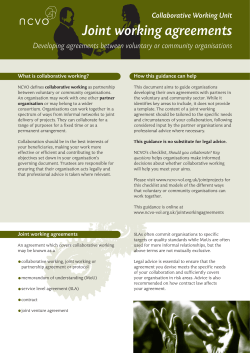
A director’s guide: How to integrate on-premise and
A director’s guide: How to integrate on-premise and cloud solutions using web services An information guide from Access consulting | software | solutions www.theaccessgroup.com Introduction All IT directors know that their organisations require access to the latest, up-to-date business information if they’re to remain agile and competitive in their marketplace. And to achieve this, tightly integrated business and accounting solutions are a must. With a wide range of on-premise and cloud-based software on the market, making the right choice can be daunting. And the IT director is often tasked with ensuring that all systems are linked up. Web services offer the IT function the flexibility to make cloud computing a reality for their business. They provide the ability for on-premise and cloudbased systems to co-exist, without having to throw out current solutions. Through close integration, real-time visibility of business data across the organisation is possible – something that you can help the business achieve. This guide aims to introduce web services, what they are, the technology, the purpose they serve and how they can benefit your business, both now and in the future. What are web services? Web services are standard software ‘components’ – or Application Programming Interfaces (APIs) – that allow communication between different platforms and software 2 packages using technologies such as .NET, HTTP, XML and SOAP. Web services can deal with any type of operation from the simple, such as weather reports and international time zone information, to the highly complex such as organisation-wide ERP solutions. Working on protocols such as SOAP means that web services are independent of any programming language or operating system. So whether a piece of software is written in C++, Perl or Java, these systems can talk to each other and exchange information over the web. That’s the beauty of web services – they enable systems to speak the same language and act as the glue that links disparate systems together. So in a nutshell, web services can be used to integrate all your systems – from finance through to CRM, manufacturing, HR and ecommerce – so that everyone has easy access to the information they need to do their job. And if they’re doing their job, they’re helping the business serve its customers better, which ultimately impacts on the bottom line. The technology The technology behind web services is pretty straightforward. We’ve included a brief overview here so that you have an idea of what it entails. Because web services allow open communication between different solutions, regardless of platform or programming language, it makes integrating solutions across the business a whole lot easier – regardless of whether they are onpremise or cloud-based. Web services use Extensible Markup Language (XML) which is a flexible means of sharing data on the web or intranets in a humanly readable form. In addition they also use three other XML-based technologies: Web Services Description Language (WSDL), Simple Object Access Protocol (SOAP) and Universal Description Discovery and Integration (UDDI). Here’s the part each plays in the process: Web services operate behind the scenes with the user working from a normal graphical interface (or GUI as it’s known) so they can easily access, edit and update information, as security permissions permit; the system simply calls the information and delivers it right to the desktop – or any other device. • WSDL is a document that points to where the web service is on the internet and its function; it is basically the interface which allows interaction with these services. It acts as a contract between the web service and the server. Because each abides by the contract, data can be exchanged. ©Access 2011. E&OE. • SOAP acts as an envelope that wraps around the XML message, sending this between the web service and the application via Hypertext Transfer Protocol (HTTP). This is basically just a vehicle which transfers data across the web. All browsers support HTTP, which is based on a synchronous request response model. An alternative to SOAP is RESTful. • UDDI is a directory of web services. It simply creates information about an organisation and what web services it provides. This searchable ‘directory’ can include listings that are either public or private. Web services often use Microsoft’s .NET Framework although they can also use Java. .NET is a common language that allows for the rapid development of APIs aimed at integrating any number of solutions together. .NET solutions simply point towards services and also enable software developers to programme against it quite quickly: web services are ‘self describing’, helping to reduce development time. Together these technologies provide the backbone that allows data exchange to take place. The result is web services that are scalable, agile, and easy to understand. All of this technology of course remains in the background – all the end user will see is a graphical interface that easily allows them to review and update information as their security level allows. Building a case for web services When building a case for web services within your organisation, you need to look for the opportunities and solutions it offers. Many businesses have staff that operate remotely or are out of the office for long periods of time. In other cases it may pay to have an element of your software in the cloud because of its elasticity and scalability due to the fact that you’re only paying for what you use. Either way, it pays to link up as many of your disparate systems as possible across the organisation. Here are just a few examples of the types of business that can utilise web services: ©Access 2011. E&OE. • Ecommerce organisations: whilst you may prefer the finance system to be operating on-premise, it’s often more cost-effective to have the ecommerce solution in the cloud and integrated into the accounts package. This is possible with web services and avoids the expense of any increased customer footfall to the website; being cloud-based means the company will not have to directly deal with IT infrastructure, any expansion or contraction in requirements, due to seasonal fluctuations, or any other associated costs. This simple process allows business to efficiently validate stock levels and trading accounts, accept orders and deal with order enquiries – all linked back to the accounting system in real-time. • Wholesale and distribution organisations: like ecommerce organisations, business-to-business (B2B) organisations, such as wholesale and distribution, have similar issues. If they receive a lot of orders to their web portal/website this puts the IT infrastructure under a great deal of strain. If a site crashes due to the demands being placed upon it, it is the IT department that suffers the blame for lost orders and annoyed customers. By placing this element of the system in the cloud, web services can easily link into other on-premise solutions such as the accounting system. • Manufacturing organisations: many manufacturers have invested a great deal in their IT infrastructure, on-premise manufacturing solutions and, for example, robotic control systems and direct interfaces, with time and attendance solutions that need to be physically on-site. It is often the case that their accounts system is also on-premise. They may however, want to combine these onpremise solutions with cloud-based CRM, document management or HR solutions. Web services will enable the integration of these systems without the manufacturing organisation having to go back to the drawing board. The IT department is pivotal in helping the business make the most of investment in existing systems where appropriate. • Multiple companies: an organisation could consist of, for example, five or more companies. By implementing web services once, each database can talk to the other. This means it’s possible to open up conversations with, for example, two or more companies at the same time. It also means that your FD(s) can gain full visibility of the accounts systems across the companies – or any of your other integrated software solutions. When conducting a review of existing systems, businesses should not assume that they have to throw these out if they continue to fit the business need. Businesses also don’t need to go down the purely on-premise or cloud route (although you can, if this is the best solution for your business). However, if the intention is to migrate to fully on-premise or cloud-based solutions then web services will help to bridge the gap, whilst the organisation is in migration mode. Hence web services can also be an interim solution as well as an end result. Business benefits The versatility of web services can provide organisations with huge benefits: Ease of integration Many organisations have disparate systems that require integration. This can often be an issue because the different software solutions are not written in the same language or don’t store their data in the same place. Web services APIs provide developers and consultants with additional tools to further extend their ability to integrate different software packages. They allow systems to talk to each other because web services are programming language and platform independent so services and information can be automatically shared. This ease of integration is brought about because neither application needs to know how the other is implemented or any formatting of data. Web services help to create more efficient business processes because there should be no duplication of effort. 3 More choice Web services open up options surrounding the technologies that you can employ, making it easy to find solutions with the right business fit. They allow businesses to integrate with software solutions where it previously would have been difficult – or impossible – to do so due to compatibility issues. Web services are also a great way to connect businesses with their customers, suppliers and other partners. Capitalise on existing investments Organisations have often invested a great deal in their systems which may be on-premise, cloud-based or a combination of the two. Regardless of the route taken, web services will enable these systems to be closely integrated. This ensures the business gains the maximum return on investment for the commitments already made. Flexibility Web services provide the freedom to choose the best software systems for your organisation. They allow the business to break out of the technological confines of being programming language and platform dependent. The complexity of modern organisations often mean they’re using a myriad of technologies to meet business needs. Because web services are able to deal with this complexity, organisations can ensure that the systems they have in place are made to work harder so the business gets more value from them. 4 Real-time data If all systems are integrated together it means that everyone is working off the same data set and that decisions are always based on the most up-todate information. The whole workflow is also improved: processes are streamlined and it’s easier to monitor status and act where appropriate as well as input information on the fly. In effect, there is less time wasted. Live data also takes away the onus on volume. As web services introduce the data, bit by bit, allowing everything to catch up, there isn’t such a huge focus on bandwidth. Cost effective The communication costs are lower because web services use existing internet capabilities. This wouldn’t be the case with the older proprietary options such as Electronic Data Interchange (EDI) or File Transfer Protocol (FTP). And because web services uses standardised technology it means less investment and faster deployment of systems because you’re able to take advantage of existing web technologies. Web services provide benefits for all organisations, no matter what their size. However, for the smaller midmarket organisation, the ability to automate processes by integrating all their systems together, means they can gain a similar level of competitive advantage as a larger organisation. Competitive advantage Integrating systems with web services means businesses can have complete visibility of information across the organisation. This is beneficial on many accounts: • It can improve the customer experience because staff can gain easy access to customer information and sales transactions, therefore, having the right information to hand at the right time. Being able to leverage this data intelligently can give an organisation the edge over its competitors. • It is easier for staff to update information in the system – whenever and wherever they are based. • It provides instant access to data from across the organisation on which business leaders can make more informed decisions. • Organisations have the opportunity to work faster, leaner and with more agility in a post-recession climate thanks to technology advancements. And this is possible by integrating all the internal systems together – and even linking with supplier and partner systems. • Organisations can react quickly to their business environment – as well as being proactive – and develop stronger relationships with partners and suppliers. ©Access 2011. E&OE. Things to consider Before going ahead with the implementation of web services you should consider the following: • Who is providing the web services? There are a couple of alternatives here. If there are two or more software solutions from different suppliers, you can engage a middleware provider to ‘connect’ the systems. Alternatively, if there is a direct relationship between the software suppliers, and they have the ability to provide web services, they will be able to carry out the process for you. This is also the case if you own or have access to the code, either directly or through a third party developer who has created the solution on your behalf. • If you are integrating to the cloud using web services ensure you have all the necessary security in place first – this will mean involving your IT team to ensure that everything is in place before you start. • When introducing web services into an organisation and interacting with the cloud, the server needs open access to the internet. Web services need to sit alongside the firewall and act as the gateway. Work in a confined and restricted manner. Web services can be secured down and it is better than exposing the Microsoft SQL database to the internet. • Start with a small but important area of the business, make sure you have the bandwidth, prove it works and become experts. Summary We hope this guide has highlighted the opportunities and choices available in the way that your systems are delivered. With web services, both on-premise and cloud computing systems can operate in harmony, sideby-side, providing your organisation with the visibility it needs to make timely business decisions. Whether you are looking for onpremise, cloud or a combination of the two, if you do your homework and ensure the financials make sense, then you’ll be able to make the right choice for your organisation. What’s more you’ll be able to integrate with the systems that you’ve already taken a great deal of time and effort to implement – helping your organisation to capitalise on your existing investment. Access Transaction Broker is a middleware application that facilitates the flow of information from third party applications into Access Dimensions. It is an ideal solution for businesses seeking to consolidate information onto a single database, or requiring a costeffective, low maintenance approach to company-wide integration. Using Transaction Broker, integration is so extensive that re-entering data becomes a thing of the past. About Access’ web services Who we are Access’ web services Application Programming Interface (API) enables our award-winning business and accounting solution, Access Dimensions, to be tightly integrated with popular cloud computing applications. These web services extend our current Dimensions API set, which allows our flagship solutions to be easily integrated with other on-premise third-party applications. Access will give you the advice, tools and clarity you need to make effective decisions, quickly and with certainty. As both a business-focused consultancy and a specialist software developer, we combine our innovative software with practical experience to deliver a solution that’s exactly right for you and your business. Our web services API provides a secure standardised interface linking directly to third-party applications whether they are on-premise or externally hosted, including cloud solutions. They operate within the .NET framework, using the Microsoft-based Windows Communications Foundation (WCF), with XML and SOAP and are hosted in Internet Information Services (IIS), which is a web server application supporting web protocols such as HTTP. As part of the Access SDK, the complete API set provides developers with even more options in how they integrate systems. This allows for the development and integration of SQL applications and a COM toolkit for linking your accounts with all COM compliant applications. In addition, we provide Access Transaction Broker, which is capable of integrating with every other type of ODBC database along with email, XML and Internet applications. We believe your solution must be ready for the future, as well as right for today. Because your business will constantly evolve, we provide a software solution that grows with you. Our modular software covers a complete range of business, financial and administration processes and can be flexed to give you the precise view of your business that you need at any time. With Access, you can be sure you’ve got the clarity you need to reach your business goals. Further information For further information on Access solutions, please telephone us on 0845 345 3300, email info@theaccessgroup.com or, alternatively, visit our website at www.theaccessgroup.com. You can also follow us on Twitter at www.twitter.com/theaccessgroup consulting | software | solutions www.theaccessgroup.com
© Copyright 2025


















